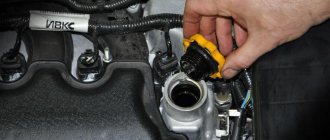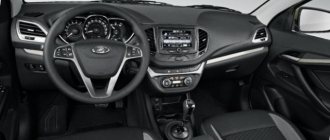Previously, we compared Vesta and its competitors (Kia Rio and Hyundai Solaris). Then it was clear that AvtoVAZ’s new product was a full-fledged player in the modern car market, capable of taking away a significant share of buyers from the leaders. In February, Solaris appeared in a new body, which was in many ways better than its predecessor. We decided to compare the Lada Vesta sedan and New Solaris.
Dimensions of Vesta and Solaris
The Lada is bigger and looks more solid. Solaris has a body length of 4370 mm, and Vesta has a body length of 4410 mm. The width ratio is 1764 mm versus 1700 in favor of the Lada Vesta. Despite the fact that the ground clearance of the Russian new product is 11 mm higher (171 – 160 mm), there is no feeling of instability. Apparently the wheelbase, which is smaller in Hyundai (2570) than in Vesta (2635), smoothes out the impression of a high seating position. Visually, Solaris looks more squat, but somewhat old-fashioned, although the objective data on aerodynamics are almost equal. The large size of a Russian car can clearly be counted as a plus.
Comparison of interiors
Even in the first videos that appeared, it became clear that the designers treated the interior design as responsibly as they did when creating a spectacular exterior. Naturally, there is no point in comparing the materials used to decorate the interior with premium models, but there is no significant difference with Solaris. One level plastic. Vesta's chairs are definitely more comfortable and better. In addition, the new Lada is freer and more comfortable than its competitor, both in the front and in the rear seats. The steering wheel is effortlessly adjustable in height and reach. The standard radio with a branded X-contour has large buttons and a modern display. In addition to regular USB and Bluetooth, the Lada has a slot for SD cards, which the Hyundai model does not have. According to experts, the acoustics and sound quality are excellent. More interesting than the “Korean” one.
Air conditioning with refrigerated storage compartment. Depending on the configuration, and there are three options - Classic, Comfort and Luxury, various combinations of options are possible in the cabin. The company plans to expand to 25 different versions. Questions arise regarding the height of the cabin. The ceiling is lower than that of Solaris, but there is more headroom in length and width, which makes driving more comfortable. The first release of 2020 will be standard, and based on the results, new variants with the most popular functions will be formed. From next 2020 until 2020, the range will be expanded to its maximum.
Comparison of configurations
Currently the prices for these cars are as follows:
- Lada Vesta from 545,900 to 735,900 rubles;
- Hyundai Solaris from 599,000 to 899,900 rubles (+ additional option packages from 30,000 to 80,000 rubles).
First, let's compare cars with minimal configurations :
- New Solaris in the basic Active configuration for 599,000 rubles;
- Vesta in Comfort version for 598,900 rubles.
The price of both cars is approximately the same, but the equipment is different:
Lada Vesta accelerates to hundreds faster and has richer equipment.
Now let's compare cars in maximum configurations :
- Lada Vesta in the Luxe Multimedia package for 735,900 rubles;
- new Solaris in the Active Plus version for 739,900 rubles.
The price of both cars is approximately the same, let's compare the options:
Options such as climate control, parking sensors and a central armrest are available on the new Solaris only in a package of options; the cost of such a car will start from 774,900 rubles.
Solaris also has exclusive options that Vesta does not have. For example, projection-type headlights with static cornering lights, heated windshield washer nozzles and heated rear seats. These options are available in the Winter option package; such a car will cost from 784,900 rubles. The most expensive configuration of the new Solaris with all possible options (which is shown in advertising) will cost 979,900 rubles. For this money you can buy THREE Lada Granta sedans!
You can independently compare the configurations of these cars on the official websites of the manufacturers (see for Vesta, for Solaris).
New Solaris, Vesta, Polo and Fiesta in a comparative review from ZaRulem:
Have you assessed all the Pros and Cons? Which car do you recommend choosing? Leave your reviews and recommendations in the comments.
Design. Lada Vesta vs Hyundai Solaris
More recently, the contour of a Korean car seemed very attractive to domestic buyers. And although the appearance of Vesta was not unexpected, there were apparently concerns that the design of the production car would differ from the concept. It's very good that this didn't happen. Domestic car enthusiasts were not deceived. Even in the most budget version, Vesta is more interesting than Solaris. The announced prices for the Russian sedan at the time of entering the market are lower.
The experience of Steve Mattin, who already has successful developments of world-class cars, inspires confidence. Delicate taste and aesthetic sense once again did not let the master down. However, let’s not forget that Russian designers also worked on his team. For them, the experience of joint creative activity will certainly be useful in future projects. The result of the work is impressive - the X design is clearly visible from the front. On the sidewalls, the idea continued in the form of stampings on the front and rear doors.
From the rear, the car looks compact, although the Lada Vesta has a larger trunk. The optics are up to par, but there is room for improvement, which is what the development team will be doing in the coming years. The difference is not very significant, but still there. The luggage compartment volume of the Solaris is 465 liters. Vesta - 480 liters. All the handles on the machine fit perfectly stylistically into the overall idea and are easy to use.
The Lada Vesta car is the first model of the Russian manufacturer...
...which turned out to be so successful that it poses serious competition to inexpensive foreign brands. Buyers are actively comparing AvtoVAZ's new product with popular Korean cars, and in many respects Lada is not inferior and even superior to foreign competitors. Today we will try to compare the Lada Vesta with the Hyundai Solaris model, which is widespread on Russian roads, and find out what the advantages and disadvantages of each of these models are.
Both cars are presented in the same price segment and class. They have similar sizes and technical characteristics. The car of the Russian manufacturer first rolled off the assembly line in 2015 and during this time it has been steadily gaining popularity among domestic buyers. In 2020, the manufacturer introduced a modification of Vesta called “Lada Vesta Cross”, which is adapted for off-road driving. It is distinguished by slightly larger body sizes, high ground clearance and some design changes.
The Solaris model is also very popular among Russian drivers. According to data for 2020, 65,581 new cars were sold, which is slightly less than the previous year, but still significant. Hyundai Solaris attracts buyers with consistently high quality, comfort and a large selection of available equipment.
The manufacturer is constantly improving its model, and in 2017 it released the updated second generation Solaris. This car surpasses its predecessor in terms of comfort, has a modified suspension and a larger body size, as well as a significantly modified design.
A Russian-made car has a more affordable price. At the same time, its basic configuration includes several additional options that Solaris does not have. So, in the simplest version, Hyundai offers the buyer an ABS system and brake force distribution, R15 steel wheels, electric windows on the front doors, adjustable steering column height, as well as 4 speakers and a prepared output for the audio system.
Lada also provides all these opportunities. But in addition to this, when purchasing a standard Vesta, the buyer receives: an anti-tow system ASR, an ESP stabilization system and an EBA emergency braking system, a steering wheel reach adjustment, electric mirror drive and heated seats.
In the top-end configuration, the functionality of both cars is approximately the same, but Vesta continues to please with a more affordable price.
Below are car prices as of July 2019
| Equipment | Cost, rub. | Engine | Power hp | checkpoint |
| Standard | 599 900 | gasoline 1.6 l. | 106 | mechanical (5) |
| Classic MT | 619900 | gasoline 1.6 l. | 106 | mechanical (5) |
| Classic start | 644900 | gasoline 1.6 l. | 106 | mechanical (5) |
| 669900 | gasoline 1.6 l. | 106 | robotic (5) | |
| Comfort MT | 704900 | petrol 1.6 | 106 | mechanical (5) |
| Comfort Image MT | 727900 | petrol 1.6 | 106 | mechanical (5) |
| Comfort AMT | 729900 | petrol 1.6 | 106 | robotic (5) |
| Comfort 1.8 MT | 762900 | petrol 1.8 | 122 | mechanical (5) |
| Luxe MT | 767900 | petrol 1.6 | 106 | mechanical (5) |
| Comfort 1.8AMT | 787900 | petrol 1.8 | 122 | robotic (5) |
| Luxe AMT | 792900 | petrol 1.6 | 106 | robotic (5) |
| Luxe Multimedia MT | 795900 | petrol 1.6 | 106 | mechanical (5) |
| Luxe 1.8MT | 802900 | petrol 1.8 | 122 | mechanical (5) |
| Luxe Prestige MT | 813900 | petrol 1.6 | 106 | mechanical (5) |
| Luxe Multimedia AMT | 820900 | petrol 1.6 | 106 | robotic (5) |
| Luxe 1.8AMT | 827900 | petrol 1.8 | 122 | robotic (5) |
| Luxe Multimedia 1.8 MT | 830900 | petrol 1.8 | 122 | mechanical (5) |
| Luxe Prestige 1.8MT | 848900 | petrol 1.8 | 122 | mechanical (5) |
| Luxe Multimedia 1.8 AMT | 855900 | petrol 1.8 | 122 | robotic (5) |
| Luxe Prestige 1.8 AMT | 873900 | petrol 1.8 | 122 | robotic (5) |
| Equipment | Active | Active Plus | Comfort | Elegance | |||
| 1.4 l 100 hp | 6MT | 6MT | 6AT | 6MT | 6AT | ||
| The cost of the car is RUB. | 746 000 | 814 000 | 854 000 | 849 000 | 889 000 | ||
| 1.6 l 123 hp | 6MT | 6AT | 6MT | 6AT | 6MT | 6AT | |
| The cost of the car is RUB. | 839 000 | 879 000 | 874 000 | 914 000 | 966 000 | 1 006 000 | |
After analyzing the data from the tables, we can conclude that Hyundai is more expensive than Vesta, but the difference in price is not critical. The most expensive configuration of a Korean car will cost a million rubles, while a top-end Russian car will be only 130 thousand cheaper.
Taking into account all the most important characteristics, we can make a list of pros and cons of competing models:
- Appearance. It is difficult to choose a winner in this category, since the choice of the car’s exterior depends on the taste and preferences of its owner. Both cars feature a dynamic, modern design and a wide choice of exterior colors.
- Interior. Inside, Vesta and Solaris are quite convenient and comfortable. The cars are quiet, but the Russian car has better sound insulation, while the controls in the Korean sedan are considered more comfortable.
- Engine. Here the advantage is on the side of Solaris, since both of its engines are more economical and demonstrate better dynamics.
- Checkpoint. The manual transmission on both the Lada and Hyundai works flawlessly. The lack of an automatic transmission is a significant drawback in the configuration of a Russian car.
- Suspension. The ride quality of both cars is also equally good. Vesta wins the debate in this regard thanks to its higher ground clearance, which provides better cross-country ability in off-road conditions.
- Cost and equipment. And the most important point that has a decisive influence on the choice is the cost of the car. Vesta clearly wins in this comparison, as it offers customers better equipment for less money. An additional advantage will be inexpensive maintenance of a Russian car.
The decision of what to choose in the end remains with the buyer. Many still prefer a time-tested foreign car, while others trust the domestic auto industry and purchase a car of decent quality for much less money. In any case, we can say that Lada Vesta attracts the attention of buyers and is a worthy competitor to foreign brands, such as the Korean Hyundai, which a few years ago had no rivals from Russia on the road.
AvtoVAZ chief designer Steve Mattin managed to create a bright, recognizable concept car that immediately attracted a lot of attention from journalists and car enthusiasts. The production car is a little different, but the basic idea is not lost. The main confirmation of this is that when comparing Vesta with modern Koreans, it cannot be said that any car clearly stands out for the better or for the worse. All three test subjects look at the same level, and it is difficult to believe that there is a Russian specimen in this trio.
Power plant, wheel transmission, etc.
The comparison will not be entirely correct. Cars have engines with significant differences in power. Undoubtedly, the choice of power units will be expanded, but for now Vesta is equipped with the VAZ 21129, a successful modification of the previous model, but with 106 hp. With. versus 126 hp obviously makes driving a Solaris more playful and dynamic. Renault's manual transmission was a smart decision and does a good job of smoothing out the difference in power. The technical capabilities will become greater after the installation of the HR 16DE, with its 114 hp. It promises to fit harmoniously into the design and its own robotic box. You won't have to wait long. When the Lada with the Sport marking, with a 1.8 liter engine and a power of 140 hp, comes off the assembly line, it will be a completely different car. Judging by the fact that the Vesta is softer and more pleasant to drive on the highway, the Russian buyer is in for a truly high-quality car. This suggests that when the design was designed, a reserve was left for more powerful power units.
A lot of interesting things are planned for next year. Both the launch of the crossover series and the base model will be produced in various body styles - the line will be complemented by a hatchback and a station wagon. How the price will react to this is not entirely clear. Although you shouldn’t trust the company’s management. For now there is hope that the cost will be somewhat lower than imported competitors. The percentage of localization will only increase. So far it is 71%, which is not small. Basic components and parts are produced in Izhevsk, including an updated automatic transmission production site. The declared fuel consumption is standard in this engine segment. In mixed mode about 7-7.5 liters. On the highway this figure can be reduced to 5 liters. In dense city traffic there is a chance to exceed 10 liters per 100 km. Low-profile tires and 17-inch wheels demonstrated at the presentation will only be installed by special order. Factory standards for luxury models are 16 inches, for regular ones 15 inches.
More details about Lada “Vesta” cars
What to take: Vesta or Solaris and which is better for our motorist?
The easiest way to assess the real capabilities of a particular car is by comparing it with a similar representative of a related class. The fact that Lada Vesta and Hyundai Solaris are direct competitors became clear after the first comparison of the models. In February 2020, the Koreans released the second generation of the sedan. Let's try to find out how much the situation has changed this time.
Competition in the automobile market is growing at a staggering rate. Many manufacturers offer models that are designed to win the attention of the consumer and win his choice to their side.
Of course, if the choice is between Zaporozhets and a car of some German brand, then the choice is clear.
After the first shows of Vesta and Solaris, it became clear that these cars compete with each other. We can talk about what is better, but after a little comparative analysis.
More about Solaris
- Which is better Lada Vesta or Hyundai Solaris, reviews
- Lada Vesta or the new Hyundai Solaris, which is better? » Lada.Online
- Automatic transmission, manual transmission for Hyundai Solaris: fuel consumption, reviews
- Comparative test of Lada Vesta with Kia Rio and Hyundai Solaris
- New Hyundai Solaris test drive
- Automatic transmission adaptation: what is it, automatic transmission reset and calibration
- Growing up with the second generation Hyundai Solaris sedan. Test drive hyundai solaris - DRIVE
- Hyundai Solaris 2019-2020: photo in the new body, photo of the salon and interior
- What to choose: Hyundai Solaris or Kia Rio
- Disadvantages of Hyundai Solaris: overview of all car problems











